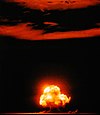The Manhattan Project was the effort, led by the United States with participation from the United Kingdom and Canada, which led to the development of the first atomic bomb during World War II. From 1942 to 1946 the project was under the command of Major General Leslie R. Groves Jr. of the US Army Corps of Engineers. The project had its roots in the Einstein–Szilárd letter, which warned that Nazi Germany might develop nuclear weapons. The letter was written by prominent physicists, signed by Albert Einstein, and delivered to President Franklin D. Roosevelt in October 1939. The Manhattan Project, which began as a small research program that year, eventually employed more than 130,000 people at a cost of nearly US$2 billion. Research and production took place at more than 30 sites, some secret, including universities across the United States, Canada, and the United Kingdom. The three primary research and production sites of the project were the plutonium-production facility at the Hanford Site in eastern Washington state, the uranium enrichment facilities at Oak Ridge, Tennessee, and the weapons research and design laboratory at Los Alamos, New Mexico. Little Boy, the bomb that was eventually dropped at Hiroshima, was a gun-type fission weapon made from uranium-235, an isotope of uranium that makes up only 0.7% of natural uranium that was produced at Oak Ridge. Fat Man, the more complex plutonium-core bomb dropped at Nagasaki, was an implosion-type nuclear weapon that required a concerted design and construction effort from Los Alamos. A plutonium bomb was the first nuclear device ever detonated, at the Trinity test in July 1945.
